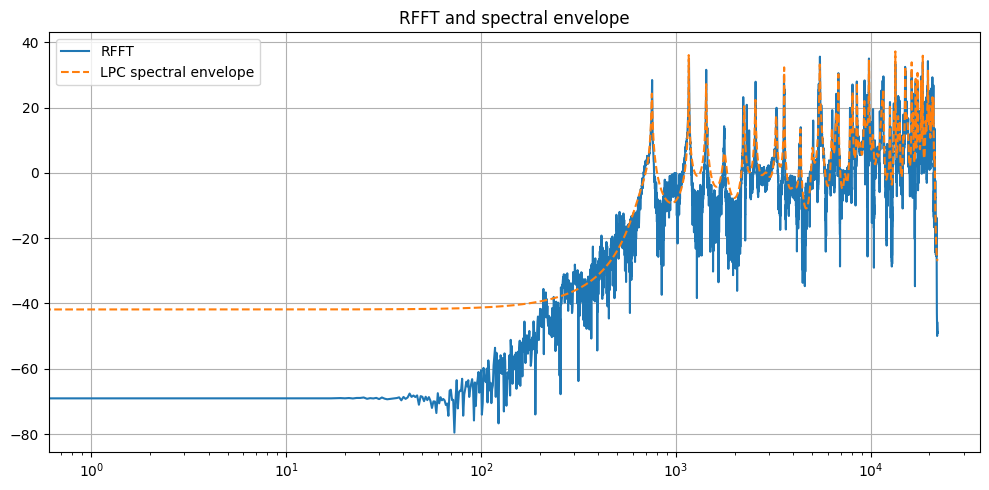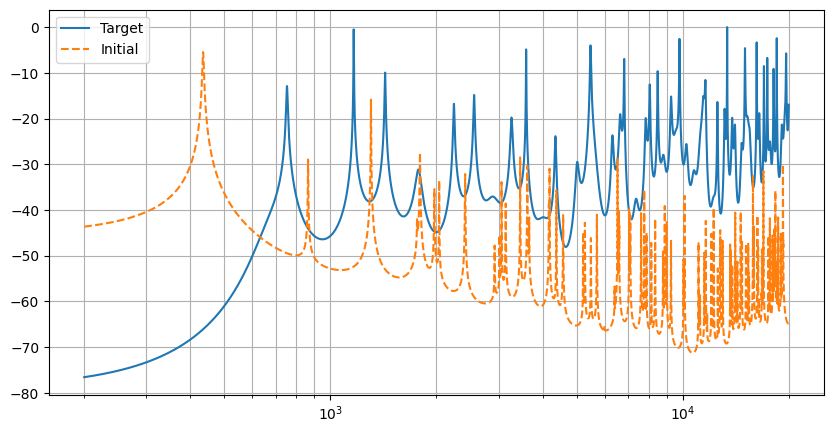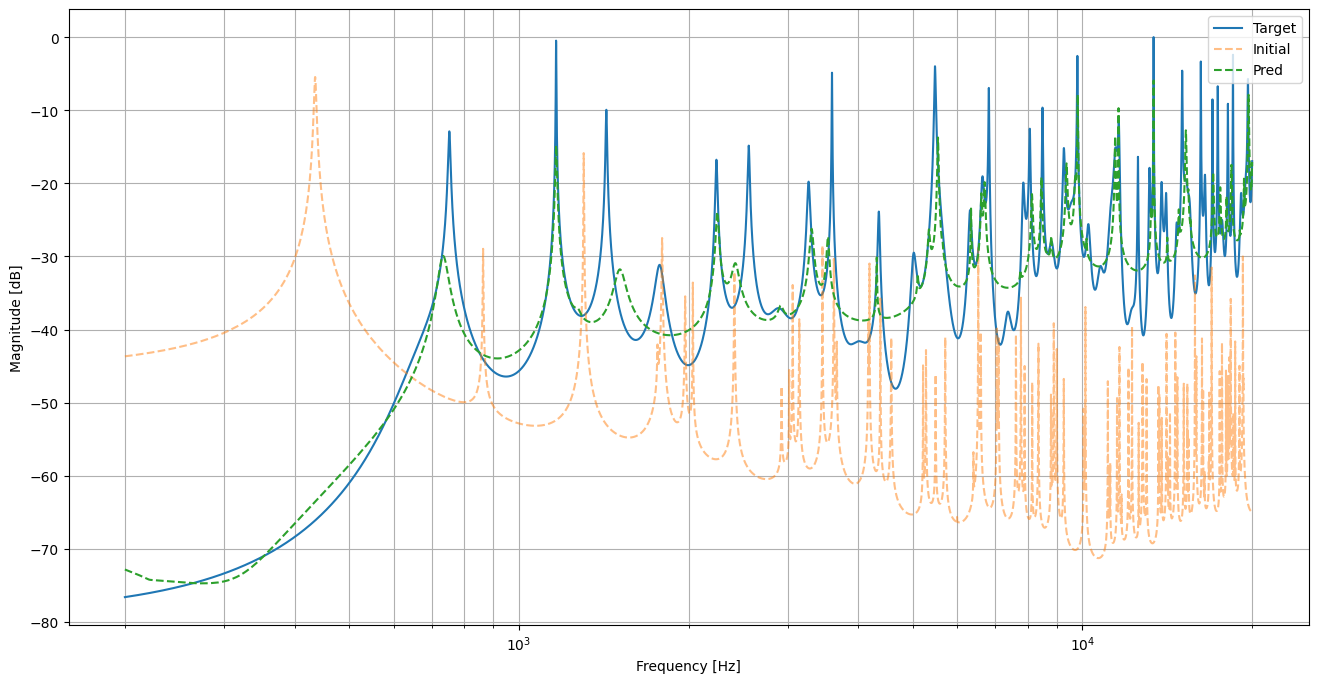This notebook shows how to fit the physical parameters of a plate to a real recording.
Load a recording of a struck plate and preprocess it
Code
stiff_string_real, file_sr = sf.read("audio/single.wav")
if file_sr != sample_rate:
print(f"Resampling from {file_sr} to {sample_rate}")
stiff_string_real = soxr.resample(
stiff_string_real,
in_rate=file_sr,
out_rate=sample_rate,
)
print("The sample rate is", sample_rate)
scale = 1
duration = 2.0
offset = int(0.00 * sample_rate)
stop = int(1 * sample_rate)
# ensure the audio has exactly the same length
stiff_string_real = stiff_string_real[offset : offset + stop]
# high pass filter the audio
b, a = butter(N=4, Wn=800, btype="high", fs=sample_rate)
stiff_string_real = lfilter(b, a, stiff_string_real)
# get the rfft of the real audio
u_stiff_string_rfft = np.fft.rfft(stiff_string_real)
# get the spectral envelope
a_lpc_cpu_solve_autocorr, g_lpc_solve_autocorr = lpc_cpu_solve(
stiff_string_real,
128,
method="autocorrelation",
biased=False,
)
w, h = freqz(
b=g_lpc_solve_autocorr,
a=np.concatenate([[1], a_lpc_cpu_solve_autocorr]),
worN=u_stiff_string_rfft.shape[0],
fs=sample_rate,
)
# impulse response
H = g_lpc_solve_autocorr / np.fft.rfft(
np.concatenate([[1], a_lpc_cpu_solve_autocorr]),
n=sample_rate,
)
y = np.fft.irfft(H, n=sample_rate)
y_rfft = np.abs(np.fft.rfft(y))
t = np.linspace(0, duration, len(stiff_string_real))
fig, ax = plt.subplots(1, 1, figsize=(10, 5))
ax.set_title("RFFT and spectral envelope")
ax.semilogx(to_db(np.abs(u_stiff_string_rfft)), label="RFFT")
ax.semilogx(w, to_db(np.abs(h)), label="LPC spectral envelope", ls="--")
ax.grid("both")
ax.legend()
fig.tight_layout()
display_audio_with_title(stiff_string_real, sample_rate, "Original")
display_audio_with_title(y, sample_rate, "LPC fit and filtered")
Resampling from 48000 to 44100
The sample rate is 44100
Original
LPC fit and filtered
Sample the envelope using the bark scale.
Code
hz_range = np.array([200, 20000])
barkrange = hz2bark(hz_range)
worN = bark2hz(np.linspace(barkrange[0], barkrange[1], 20000))
w, h = freqz(
g_lpc_solve_autocorr,
a=np.concatenate([[1], a_lpc_cpu_solve_autocorr]),
worN=worN,
fs=sample_rate,
)
target_freq_resp = jnp.abs(h) / jnp.max(jnp.abs(h))
Define the initial parameters and constraints.
Code
RANGE_BENDING_STIFFNESS = 15000
rng = np.random.default_rng(654)
pars = {
"bending_stiffness": rng.normal(),
"gamma_mu": jnp.linspace(5, 15, n_modes),
"d1": rng.normal(),
"d3": rng.normal(),
"Ts0": rng.normal(),
"l1": rng.normal(),
"l2": rng.normal(),
"z0": rng.normal(size=(n_modes, 1)).astype(np.float32),
"gain": rng.normal(scale=1e-3),
"zero_radii": rng.normal(size=(n_modes)).astype(np.float32),
"zero_angles": rng.normal(size=(n_modes)).astype(np.float32),
}
def get_bending_stiffness(params):
return jax.nn.sigmoid(params["bending_stiffness"]) * RANGE_BENDING_STIFFNESS
def get_l1(params):
return jax.nn.sigmoid(params["l1"])
def get_l2(params):
return jax.nn.sigmoid(params["l2"])
def get_z0(params):
return params["z0"]
def get_gamma_mu(params):
return -jax.nn.relu(params["gamma_mu"])
# return -jnp.exp(params["gamma_mu"])
def get_Ts0(params):
return 0.0
def get_gain(params):
return params["gain"]
def get_zeros(pars):
return jax.nn.sigmoid(pars["zero_radii"]) * jnp.exp(
2j * np.pi * jax.nn.sigmoid(pars["zero_angles"])
)
Simulate the plate using the initial parameters.
Code
def tf_modified(
pars,
lambda_mu,
dt,
):
omega_mu_squared = (
get_bending_stiffness(pars) * lambda_mu**2 + get_Ts0(pars) * lambda_mu
)
gamma_mu = get_gamma_mu(pars)
omega_mu = jnp.sqrt(omega_mu_squared - gamma_mu**2)
# discretise
radius = jnp.exp(gamma_mu * dt)
real = radius * jnp.cos(omega_mu * dt)
zeros = get_zeros(pars)
b1 = -2.0 * zeros.real
b2 = zeros.real**2 + zeros.imag**2
a1 = -2.0 * real
a2 = radius**2
ones = jnp.ones_like(lambda_mu)
b = jnp.stack([ones, b1, b2], axis=-1)
a = jnp.stack([ones, a1, a2], axis=-1)
return b, a
def simulate_membrane(pars):
wnx, wny = plate_wavenumbers(
n_max_modes_x,
n_max_modes_y,
get_l1(pars),
get_l2(pars),
)
lambda_mu = plate_eigenvalues(wnx, wny).reshape(-1)
lambda_mu = lambda_mu.reshape(-1).sort()[:n_modes]
b, a = tf_modified(pars, lambda_mu, dt)
b = b * get_z0(pars) * get_gain(pars)
h = tf_freqz(b, a, worN, sample_rate)
pred_freq_resp = jnp.mean(jnp.abs(h), axis=0)
return pred_freq_resp, b, a
initial_freq_resp, b, a = simulate_membrane(pars)
fig, ax = plt.subplots(1, 1, figsize=(10, 5))
ax.semilogx(
worN,
to_db(target_freq_resp),
label="Target",
)
ax.semilogx(
worN,
to_db(initial_freq_resp),
label="Initial",
ls="--",
)
ax.grid(which="both")
_ = ax.legend()
x = jnp.zeros(shape=(sample_rate), dtype=jnp.float32)
x = x.at[0].set(1.0)
pred_imp_resp = iir_filter_parallel(b, a, x).mean(axis=1)
display_audio_with_title(y, sample_rate, "Target")
display_audio_with_title(pred_imp_resp, sample_rate, "Initial")
Target
Initial
Optimise the parameters using gradient descent.
Code
iterations = 30_000
learning_rate = 1e-2
scheduler = optax.cosine_onecycle_schedule(
transition_steps=iterations,
peak_value=learning_rate,
)
optimiser = optax.chain(
optax.clip_by_global_norm(2.0),
optax.adam(learning_rate=scheduler),
)
state = optimiser.init(pars)
@jax.jit
def train_step(pars, state):
def loss_fn(pars):
pred_freq_resp, b, a = simulate_membrane(pars)
log_pred_freq_resp = safe_log(pred_freq_resp)
log_target_freq_resp = safe_log(target_freq_resp)
lin_diff = pred_freq_resp - target_freq_resp
log_diff = log_pred_freq_resp - log_target_freq_resp
lin_l2_loss = jnp.mean(
jnp.square(
lin_diff,
),
)
log_l1_loss = jnp.mean(
jnp.abs(
log_diff,
),
)
sc_loss = spectral_convergence_loss(
log_pred_freq_resp,
log_target_freq_resp,
)
ot_loss = jnp.mean(
spectral_wasserstein(
pred_freq_resp,
target_freq_resp,
squared=True,
is_mag=True,
)
)
return lin_l2_loss + log_l1_loss * 0.1 + sc_loss + ot_loss * 0.001
loss, grads = jax.value_and_grad(loss_fn)(pars)
updates, state = optimiser.update(grads, state, pars)
pars = optax.apply_updates(pars, updates)
return pars, state, loss
bar = tqdm(range(iterations))
for i in bar:
pars, state, loss = train_step(pars, state)
bar.set_description(
f"Loss: {loss:.3f}, bending_stiffness: {get_bending_stiffness(pars):.3f}, l1: {get_l1(pars):.3f}, l2: {get_l2(pars):.3f}"
)
Loss: 0.158, bending_stiffness: 3998.537, l1: 0.738, l2: 0.357: 100%|██████████| 30000/30000 [00:47<00:00, 632.80it/s]
Target
Optimised


